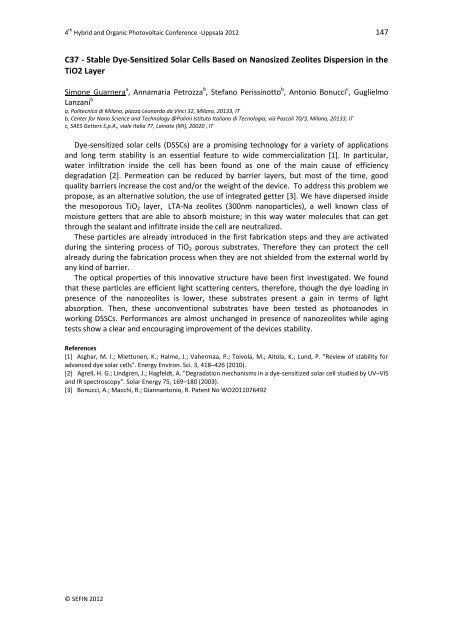HOPV12 - Blogs
HOPV12 - Blogs
HOPV12 - Blogs
You also want an ePaper? Increase the reach of your titles
YUMPU automatically turns print PDFs into web optimized ePapers that Google loves.
4 th Hybrid and Organic Photovoltaic Conference -Uppsala 2012 147<br />
C37 - Stable Dye-Sensitized Solar Cells Based on Nanosized Zeolites Dispersion in the<br />
TiO2 Layer<br />
Simone Guarnera a , Annamaria Petrozza b , Stefano Perissinotto b , Antonio Bonucci c , Guglielmo<br />
Lanzani b<br />
a, Politecnico di Milano, piazza Leonardo da Vinci 32, Milano, 20133, IT<br />
b, Center for Nano Science and Technology @Polimi Istituto Italiano di Tecnologia, via Pascoli 70/3, Milano, 20133, IT<br />
c, SAES Getters S.p.A., viale Italia 77, Lainate (MI), 20020 , IT<br />
Dye-sensitized solar cells (DSSCs) are a promising technology for a variety of applications<br />
and long term stability is an essential feature to wide commercialization [1]. In particular,<br />
water infiltration inside the cell has been found as one of the main cause of efficiency<br />
degradation [2]. Permeation can be reduced by barrier layers, but most of the time, good<br />
quality barriers increase the cost and/or the weight of the device. To address this problem we<br />
propose, as an alternative solution, the use of integrated getter [3]. We have dispersed inside<br />
the mesoporous TiO2 layer, LTA-Na zeolites (300nm nanoparticles), a well known class of<br />
moisture getters that are able to absorb moisture; in this way water molecules that can get<br />
through the sealant and infiltrate inside the cell are neutralized.<br />
These particles are already introduced in the first fabrication steps and they are activated<br />
during the sintering process of TiO2 porous substrates. Therefore they can protect the cell<br />
already during the fabrication process when they are not shielded from the external world by<br />
any kind of barrier.<br />
The optical properties of this innovative structure have been first investigated. We found<br />
that these particles are efficient light scattering centers, therefore, though the dye loading in<br />
presence of the nanozeolites is lower, these substrates present a gain in terms of light<br />
absorption. Then, these unconventional substrates have been tested as photoanodes in<br />
working DSSCs. Performances are almost unchanged in presence of nanozeolites while aging<br />
tests show a clear and encouraging improvement of the devices stability.<br />
References<br />
[1] Asghar, M. I.; Miettunen, K.; Halme, J.; Vahermaa, P.; Toivola, M.; Aitola, K.; Lund, P. "Review of stability for<br />
advanced dye solar cells". Energy Environ. Sci. 3, 418–426 (2010).<br />
[2] Agrell, H. G.; Lindgren, J.; Hagfeldt, A. "Degradation mechanisms in a dye-sensitized solar cell studied by UV–VIS<br />
and IR spectroscopy". Solar Energy 75, 169–180 (2003).<br />
[3] Bonucci, A.; Macchi, R.; Giannantonio, R. Patent No WO2011076492<br />
© SEFIN 2012


